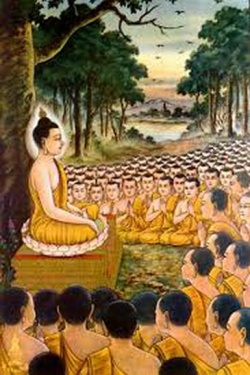Difference between revisions of "When And How The Disciplinary Rules Were Laid Down"
(Created page with "thumb|250px| <poem> For twenty years after the establishment of the Order there was neither injunction nor rule concerning Parajika and Samghadisesa offen...") |
|||
| Line 1: | Line 1: | ||
[[File:147ages.jpg|thumb|250px|]] | [[File:147ages.jpg|thumb|250px|]] | ||
<poem> | <poem> | ||
| − | For twenty years after the establishment of the Order there was neither injunction nor rule concerning Parajika and Samghadisesa offences. The members of the Order of the early days were all Ariyas, the least advanced of whom was a Stream-winner, one who had attained the first Magga and Fruition, and there was no need for prescribing rules relating to grave offences. | + | For twenty years after the establishment of the Order there was neither injunction nor rule concerning [[Parajika]] and Samghadisesa offences. The members of the Order of the early days were all [[Ariyas]], the least advanced of whom was a [[Stream-winner]], one who had [[attained]] the first [[Magga]] and [[Fruition]], and there was no need for prescribing rules relating to grave offences. |
| − | But as the years went by, the Samgha grew in strength. Undesirable elements not having the purest of motives but attracted only by the fame and gain of the bhikkhus began to get into the Buddha's Order. Some twenty years after the founding of the Order, it became necessary to begin establishing rules relating to grave offences. | + | But as the years went by, the [[Samgha]] grew in strength. Undesirable [[elements]] not having the purest of motives but attracted only by the [[fame]] and gain of the [[bhikkhus]] began to get into the [[Buddha's]] Order. Some twenty years after the founding of the Order, it became necessary to begin establishing rules relating to grave offences. |
| − | It was through Bhikkhu Sudinna, a native of Kalanda Village near Vesali, who committed the offence of having sexual intercourse with his ex-wife, that the first Parajika rule came to be promulgated. It was laid down to deter bhikkhus from indulging in sexual intercourse. | + | It was through [[Bhikkhu]] Sudinna, a native of [[Kalanda]] Village near [[Vesali]], who committed the offence of having {{Wiki|sexual}} intercourse with his ex-wife, that the first [[Parajika]] rule came to be promulgated. It was laid down to deter [[bhikkhus]] from indulging in {{Wiki|sexual}} intercourse. |
| − | When such a grave cause had arisen for which the laying down of a prohibitory rule became necessary, the Buddha convened an assembly of the bhikkhus. It was only after questioning the bhikkhu con- cerned and after the undesirability of committing such an offence had been made clear that a certain rule was laid down in order to prevent future lapses of similar nature. | + | When such a grave [[cause]] had arisen for which the laying down of a prohibitory rule became necessary, the [[Buddha]] convened an assembly of the [[bhikkhus]]. It was only after questioning the [[bhikkhu]] con- cerned and after the undesirability of committing such an offence had been made clear that a certain rule was laid down in order to prevent {{Wiki|future}} lapses of similar [[nature]]. |
| − | The Buddha also followed the precedence set by earlier Buddhas. Using his supernormal powers, he reflected on what rules the earlier Buddhas would lay down under certain given conditions. Then he adopted similar regulations to meet the situation that had arisen in his time. | + | The [[Buddha]] also followed the precedence set by earlier [[Buddhas]]. Using his [[supernormal powers]], he reflected on what rules the earlier [[Buddhas]] would lay down under certain given [[conditions]]. Then he adopted similar regulations to meet the situation that had arisen in his [[time]]. |
</poem> | </poem> | ||
{{W}} | {{W}} | ||
[http://www.wisdomlib.org/buddhism/book/guide-to-tipitaka/d/doc3416.html www.wisdomlib.org] | [http://www.wisdomlib.org/buddhism/book/guide-to-tipitaka/d/doc3416.html www.wisdomlib.org] | ||
[[Category:Vinaya Pitaka]] | [[Category:Vinaya Pitaka]] | ||
Latest revision as of 15:10, 19 March 2014
For twenty years after the establishment of the Order there was neither injunction nor rule concerning Parajika and Samghadisesa offences. The members of the Order of the early days were all Ariyas, the least advanced of whom was a Stream-winner, one who had attained the first Magga and Fruition, and there was no need for prescribing rules relating to grave offences.
But as the years went by, the Samgha grew in strength. Undesirable elements not having the purest of motives but attracted only by the fame and gain of the bhikkhus began to get into the Buddha's Order. Some twenty years after the founding of the Order, it became necessary to begin establishing rules relating to grave offences.
It was through Bhikkhu Sudinna, a native of Kalanda Village near Vesali, who committed the offence of having sexual intercourse with his ex-wife, that the first Parajika rule came to be promulgated. It was laid down to deter bhikkhus from indulging in sexual intercourse.
When such a grave cause had arisen for which the laying down of a prohibitory rule became necessary, the Buddha convened an assembly of the bhikkhus. It was only after questioning the bhikkhu con- cerned and after the undesirability of committing such an offence had been made clear that a certain rule was laid down in order to prevent future lapses of similar nature.
The Buddha also followed the precedence set by earlier Buddhas. Using his supernormal powers, he reflected on what rules the earlier Buddhas would lay down under certain given conditions. Then he adopted similar regulations to meet the situation that had arisen in his time.
Source
Wikipedia:When And How The Disciplinary Rules Were Laid Down
www.wisdomlib.org
